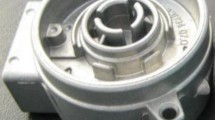Abstract
The present investigation focuses on finding the optimal machining parameters’ setting for the die casting process of magnesium alloy using the grey-based fuzzy algorithm. This proposed algorithm, coupling the grey relational analysis with the fuzzy logic, obtains a grey-fuzzy reasoning grade to evaluate the multiple performance characteristics according to the grey relational coefficient of each performance characteristic. One of the real case studies performed in the die casting process, thin-walled cover components of liquid crystal display (LCD) panel, verifies that the proposed optimum procedure is feasible and effective. The casting density, warpage and flow mark of finished product are adopted to evaluate the machiniablity performances. Various die casting parameters, such as the die temperature, the pressure of injection, the plunger velocity (first and second stage) and the filling time are explored in the experiment. The table of orthogonal array is used in the experimental design. The response table, response graph and analysis of variance (ANOVA) are used to find the optimal setting and the influence of machining parameters on the multiple performance characteristics. Under the circumstances of the optimal machining parameters, the confirmation tests indicate the effectiveness of the proposed algorithm. Experimental results have shown that the required performance characteristics in the die casting process have great improvements by using this proposed algorithm.
Similar content being viewed by others
References
Brungs D (1997) Light weight design with light metal castings. Mater Des 18:285–291
Gutman EM, Unigovski Ya, Levkovich M, Koren Z, Aghion E (1997) Influence of technological parameters of permanent mold casting and die casting on creep and strength of Mg alloy AZ91D. Mater Sci Eng A 234–236:880–883
Dahle AK, Sannes S, St. John DH, Westengen H (2001) Formation of defect bands in high pressure die cast magnesium alloys. J Light Metals 1:99–103
Hu BH, Tong KK, Niu XP, Pinwill I (2000) Design and optimization of runner and gating systems for the die casting of thin-wall magnesium telecommunication parts through numerical simulation. J Mater Process Technol 105:128–133
Tong KS, Hu B, Niu HX, Pinwill PI (2002) Cavity pressure measurement and process monitoring for magnesium die casting of a thin-wall hand-phone component to improve quality. J Mater Process Technol 127:238–241
Syrcos GP (2003) Die casting process optimization using Taguchi methods. J Mater Process Technol 135:68–74
Wu DH, Chang MS (2004) Use of Taguchi method to develop a robust design for the magnesium alloy die casting process. Mater Sci Eng A 379:366–371
Lee SG, Patel GR, Gokhale AM (2005) Characterization of the effects of process parameters on macrosegregation in a high-pressure die-cast Magnesium alloy. Mater Charact 55:219–224
Kadiri HE, Xue Y, Horstemeyer MF, Jordon JB, Wang PT (2006) Identification and modeling of fatigue crack growth mechanisms in a die-cast AM50 magnesium alloy. Acta Mater 54:5061–5076
Cerri E, Leo P, De Marco PP (2007) Hot compression behavior of the AZ91 magnesium alloy produced by high pressure die casting. J Mater Process Technol 189:97–106
Wang YC, Li DY, Peng YH, Zeng XQ (2007) Numerical simulation of low pressure die casting of magnesium wheel. Int J Adv Manuf Technol 38:257–264
Deng JL (1989) Introduction to grey system. J Grey Sys 1(1):1–24
Deng JL (1982) Control problems of grey systems. Sys Control Lett 52:88–294
Lin JL, Lin CL (2002) The use of orthogonal array with Grey relational analysis to optimize the electrical discharge machining process with multiple performance characteristics. Int J Mach Tools Manuf 42:237–244
Narender Singh P, Raghukandan K, Pai BC (2004) Optimization by Grey relational analysis of EDM parameters on machining Al-10%SiCp composites. J Mater Process Technol 155–156:1658–1661
Zadeh L (1965) Fuzzy sets. Information Control 8:338–353
Zimmermann HJ (1985) Fuzzy set theory and its applications. Kluwer, London
Lin CL, Lin JL, Ko TC (2002) Optimisation of the EDM process based on the orthogonal array with fuzzy logic and grey relational analysis method. Int J Adv Manuf Technol 19:271–277
Lin JL, Lin CL (2005) The use of grey-fuzzy for the optimization of the manufacturing process. J Mater Process Technol 160:9–14
Wang WP, Peng YH, Li XY (2002) Fuzzy-grey prediction of cutting force uncertainty in turning. J Mater Process Technol 129:663–666
Albert WL, Yao SC, Chen CK (2005) Development of an integrated Grey-fuzzy-based electricity management system for enterprises. Energy 30:2759–2771
Karmakar S, Mujumdar PP (2006) Grey fuzzy optimization model for water quality management of a river system. Adv Water Resour 29:1088–1105
Fisher RA (1925) Statistical method for research worker. Oliver & Boyd, London
Author information
Authors and Affiliations
Corresponding author
Rights and permissions
About this article
Cite this article
Chiang, KT., Liu, NM. & Chou, CC. Machining parameters optimization on the die casting process of magnesium alloy using the grey-based fuzzy algorithm. Int J Adv Manuf Technol 38, 229–237 (2008). https://doi.org/10.1007/s00170-007-1103-z
Received:
Accepted:
Published:
Issue Date:
DOI: https://doi.org/10.1007/s00170-007-1103-z




